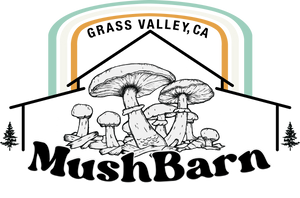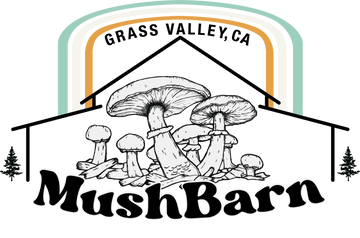FAQ
Mushroom Grow Kit FAQs
Q: How often do I spray mist onto my grow kit?
A: Keeping your activated grow kit on the kitchen counter is a great place to ensure you remember to spray it frequently enough. The more you spray, the better the results. A few times a day is ideal, each time pumping the spray mister 5-10 pumps. Mushrooms love humidity, so the more the better!
Q: What are ideal conditions for my mushroom grow kit? Can it grow outside?
A: Our Oyster mushroom, Chestnut mushroom, and Lion's Mane mushroom Grow kits are designed for indoor use and do best in temperatures between 65-75°F, but can tolerate a larger range. They can be grown outside if your outdoor temperatures are within the ideal range or slightly cooler, but keep in mind you will likely need to provide extra humidity to ensure good fruitings.
Q: How many mushrooms will my kit produce?
A: Production can vary by kit, with some producing around 2 pounds of mushrooms total.
Q: Is the white growth on my grow kit mold?
A: No, the white substance is mycelium, a critical part of the mushroom's vegetative growth, not mold.
Q: How do I water my mushroom grow kit?
A: Spray where you poked the hole with the spray bottle filled with water. It's recommended to use the provided spray bottle to mist the grow multiple times daily, maintaining moisture for optimal growth. If you skip a day or forget a day don’t worry, the mycelium can tolerate a short dry spell.
Lion's Mane
Q: What should I do if my block is cracked or has started growing before I opened it?
A: Cracks or pre-growth are common and usually not a cause for concern. Email us at mushbarn@gmail.com if you have any concerns.
Oyster mushrooms
Q: When do I harvest my oyster mushrooms?
A: Harvest blue or pearl oyster mushrooms when the cap starts to flatten out from the stem, which may be a bit later than you expect.
Oyster Mushrooms
Q: My oyster mushrooms started out bright but then faded. What should I do?
A: This fading can happen due to age or direct sun exposure. Harvest these mushrooms and modify your cultivation approach for future flushes.
Q: Can I get more than one flush (harvest) from my grow kit?
A: Yes, with proper care, including avoiding dryness and extreme temperatures, you can get multiple flushes from your grow kit.
Q: What do I do with the grow kit after it's finished producing mushrooms?
A: The spent substrate can be used as mulch or a soil amendment in your garden, potentially providing more mushrooms under the right conditions!
Q: How do I know when to harvest my mushrooms?
A: Look for signs like the mushrooms no longer doubling in size daily and a change in color.
Storage and Aftercare
Q: How should I store harvested mushrooms?
A: Keep them in a dry, breathable container in the fridge and consume within a week for the best taste. We prefer paper grocery bags tightly folded.
Q: Can I eat mushrooms raw from the kit?
A: NO! Always cook raw mushrooms thoroughly! Never eat mushrooms raw. They are made of an indigestible fiber called chitin, the same molecule as crab shells and eggshells. Humans do not possess the enzymes to break down chitin unless it is exposed to high temperatures - heating it.
Mushroom Identification and Foraging
Q: How can I safely identify wild mushrooms?
A: Mushroom identification requires careful examination of several characteristics, including cap shape, color, gills, stem, and spore print, among others. Always consult with a local expert or mycologist and use reputable identification guides. When foraging, follow the rule: When in doubt, throw it out. Never consume a wild mushroom unless you are 100% sure of its identity and it is thoroughly cooked.
Q: Are there any tools or apps that can help with mushroom identification?
A: There are apps and websites that offer identification tools, but they should not replace expert advice or thorough field guides. Always cross-reference information and consult with an expert.
Q: Can I cultivate mushrooms on logs or in my garden?
A: Yes, mushrooms such as shiitake, oyster, and lion's mane can be cultivated on logs, while king stropharia (Garden Giant) mushrooms are well-suited for outdoor garden beds. Log cultivation involves inoculating hardwood logs with spawn and requires patience, as it may take a year or more before the first mushrooms appear. Garden Giant cultivation often involves layering spawn with wood chips or straw.
Q: What is the best time of year to start an outdoor mushroom garden?
A: This depends on your climate and the species you wish to grow. Generally, early spring or fall is ideal for setting up outdoor cultivation, aligning with natural rainfall and temperature conditions conducive to mushroom growth. But mushroom cultivation can begin any time of year with a little extra care!
Health and Safety
Q: Are there health benefits to consuming mushrooms?
A: Many mushrooms are rich in vitamins, minerals, antioxidants, and fiber, offering various health benefits. For example, they can support immune function, reduce inflammation, and contribute to heart health. However, the nutritional content and benefits can vary greatly between species.
Culinary Uses
Q: How should I store fresh mushrooms to extend their shelf life?
A: Store fresh mushrooms in the refrigerator, ideally in a paper bag to allow them to "breathe." Avoid washing them until right before use to prevent them from becoming slimy. Most fresh mushrooms will keep for up to a week when stored properly.
Q: Can I cook with dried mushrooms?
A: Yes, dried mushrooms can be a wonderful ingredient. They can be rehydrated in warm water for about 20 minutes before use. The soaking liquid is flavorful and can be used as a broth or sauce base.
Environmental Impact
Q: Do mushrooms have an environmental impact?
A: Mushrooms play a crucial role in ecosystems as decomposers, breaking down organic matter and recycling nutrients. Cultivating mushrooms can also have environmental benefits, such as utilizing agricultural byproducts and contributing to soil health. However, foraging should be done responsibly following proper foraging etiquette to avoid damaging natural habitats.
Q: Can mushrooms contribute to sustainable agriculture?
A: Yes, mushrooms can contribute to sustainable agriculture practices by breaking down organic waste into fertile soil, helping with composting efforts, and even cleaning up environmental contaminants through a process known as mycoremediation. They require less land and water than traditional crops, making them an efficient and sustainable food source.


